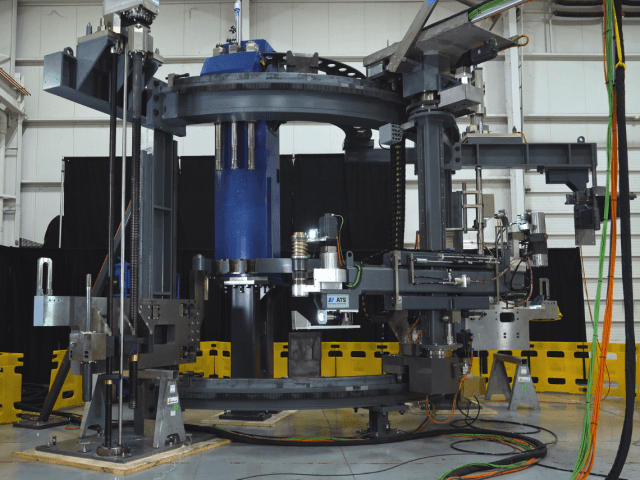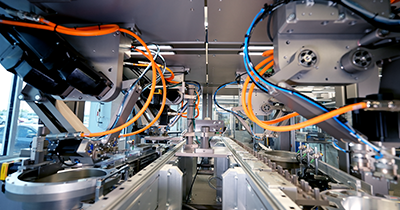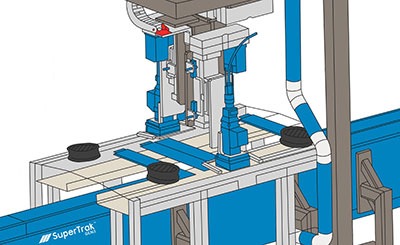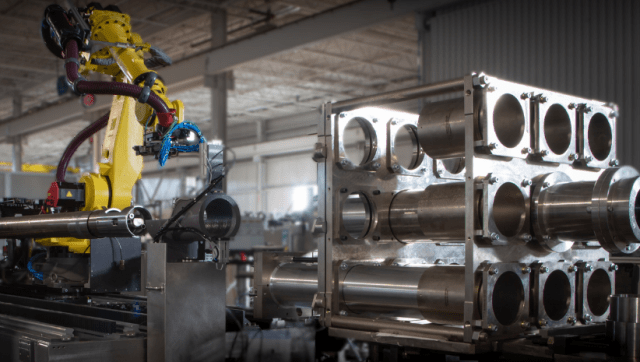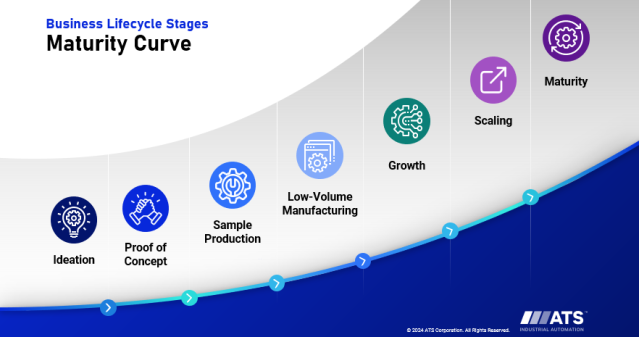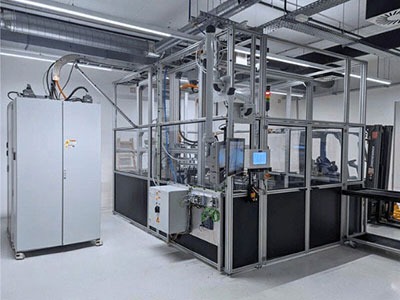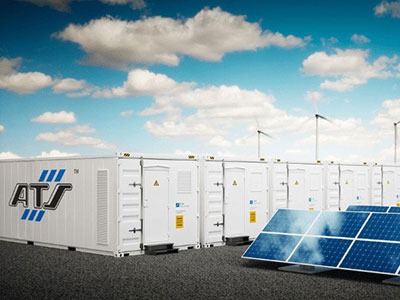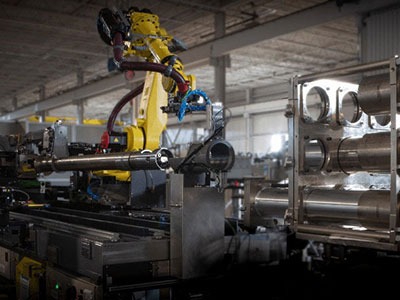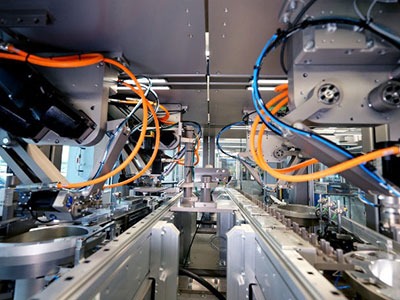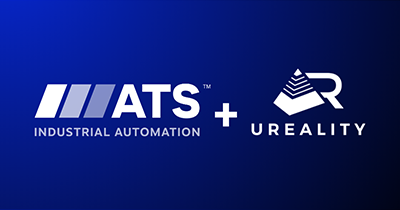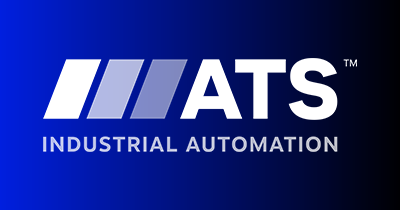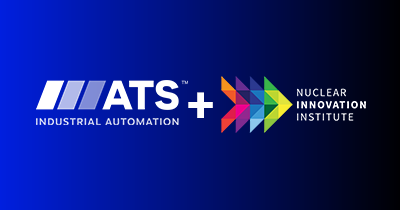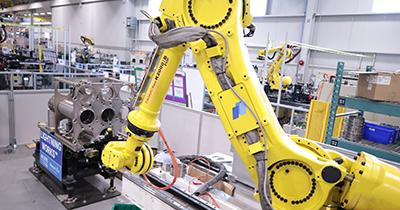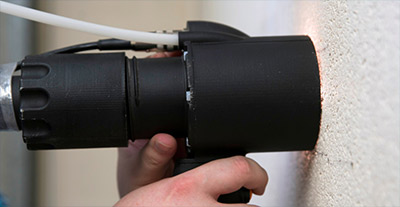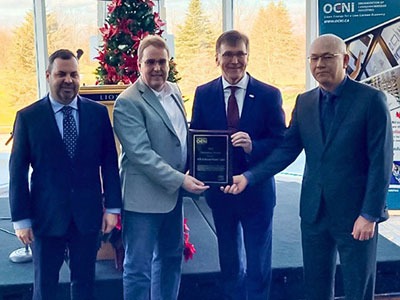March 8, 2022
The past two years have severely strained the global supply chain. Short-term fixes are no longer enough; reshoring assembly is now viable and profitable. Consumer Packaged Goods brands can now control and meet regional demand with agile and digital high-speed assembly.
In this webinar experts explain:
- How CPG companies succeed with agility to satisfy shifting demands.
- How companies can leverage assembly assets to quickly go from prototype to production.
- How to utilize digital technology to allow for high-speed and agile production of multiple products for just in time delivery.
- How other customers are succeeding at agile CPG assembly with benchmark case studies.
Watch “Reshoring CPG with Agile Automation” Webinar Now
Speakers
Host
John Sprovieri
Editor-in-Chief, Assembly Magazine.
Speaker
Christopher Spayd
Sales Manager, ATS Industrial Automation.
Speaker
Peng Cau
Vice President, Symphoni™.
Transcript
John Sprovieri
Good afternoon. This is John Sprovieri, the chief editor of Assembly Magazine. Welcome to our latest webinar, Reshoring Consumer Goods with Agile Automation. This event is sponsored by ATS Industrial Automation. Today’s presenters are Christopher Spayd and Peng Cau.
Chris has spent nearly eighteen years developing automation systems. He has overseen hundreds of automated machine configurations, bringing his unique thought process to help customers streamline and move faster. Over the past year, Chris has shifted from engineering and today works directly with customers. Working with clients, Chris brings high-speed assembly and automation know-how to consumer goods manufacturers, helping them find the optimal solution for their business with the most economical cost of ownership (TCO).
Peng was the CEO and co-founder of Transformix Engineering, an innovator of advanced manufacturing technologies. After selling Transformix IP to ATS, she spun off Transformix’s manufacturing division with three former managers, to preserve jobs, and joined ATS as its VP of emerging markets and Symphoni. Peng has received many awards including induction into the Kingston Business Hall of Fame, women Exporter of the Year and an honorary diploma from St. Lawrence College. She is a director on several boards. She’s a coach, mentor, conference speaker, and has been featured in local and national media. Peng came to Canada with her family as a refugee from Cambodia.
Now, this is a live program so please do submit questions for our speakers. Later in the program, we will address as many as possible. Today’s event is being recorded and will be archived on our website assemblymag.com. And now, without further adieu, I’m excited to turn it over to today’s presenters. Chris and Peng. Take it away.
Peng Cau
Hello, ladies and gentlemen. Welcome. And thank you for taking the time with Chris and me to explore how companies can reshore their assembly processes with fast, flexible, and precise digital assembly technologies. By the end of our one hour together, I hope we’ll have a strong grasp on not just reshoring, but the technology that can make it possible. We’ll talk about why the consumer packaged goods industry must turn to agile solutions to satisfy an increasingly complicated supply and demand landscape, leverage assembly assets to shorten time to market, utilize digital technology to allow for high-speed production of multiple products and just in time delivery, and find the right automation partners to reduce risk.
I’ve been in the automation industry for over twenty-seven years. As John mentioned earlier, I founded an automation company in 1995 with three engineers. And, because of the length of time that I’ve been building continuous motion and indexing motion machines, I’ve spent a lot of time thinking about the big ideas of manufacturing. There are larger forces at play in the future of our industry. Now more than ever, that future is filled with uncertainty and instability, and businesses are forced to adapt to survive and thrive.
If we take a wide view for a moment, the last two decades have seen the rise of e-commerce, rapidly evolving consumer behavior, climate change, political upheaval, the Internet of Things (IoT), the rise of China, a historically unique macro-economic environment for inflation and interest rates, and of course, the relentless march of automation across every industry. All these questions are in search of answers, and businesses must respond whether they’re equipped or not. The COVID-19 pandemic has merely accelerated trends that were already in motion for many years. Likewise, the geopolitical earthquake that has been on everyone’s mind, Russia’s invasion of Ukraine, exasperated our supply chain issues. It is hard to deny that both slowly and suddenly, the world has changed. And with it, how we do business.
The numbers you see here on the slide are from a McKinsey and Company report, which shows the vulnerability of the global supply chain not just to COVID-19, but to the other shocks that I just mentioned. In the first year of COVID-19 alone, US and European companies lost up to $4 trillion in revenue to supply chain problems. No one could have predicted this in 2019. Now that we experienced the weaknesses in the global supply chain, companies and governments see COVID-19 as an accelerator, not a blip. These disruptions will happen and flow over the coming decades, but they will not disappear. Some of these we can predict and plan for, others we can’t.
We’re doing a quick poll right now to see how the supply chain has affected your organization. We’ll give you about fifteen to twenty seconds to do the poll. Great, the results are coming in. Even though we are in a very different place with COVID-19 than when the survey was taken in May 2020, we can see that respondents were accurate in how they believed things would unfold. Specifically, the biggest predicted trend is the adoption of automation technologies to build resiliency and agility, to adapt to rapid changes. Manufacturing is not returning to the old ways. We have moved beyond the assembly line dedicated to producing singular products or offshoring to cheap labor countries. Businesses that depend on supply chains crossing international borders are more vulnerable to economic, financial, ecological, political, and geopolitical shocks, as we are currently seeing.
The obvious answer, then, is to reverse offshoring. Even before the current crisis, reshoring was becoming more attractive in the last ten years, especially with the rise of China, which benefits so greatly from our offshoring. Over the past thirty-five years, this has naturally resulted in much higher costs in that country, as their middle income continues to rise. It’s a little bit more complicated than a simple pendulum of labor costs swinging back and forth, as there’s always somewhere that is normally cheaper.
The more profound global change that makes reshoring possible is a revolution in automation technology that we will discuss today. The kind of automation that I’m talking about is digital, standardized, modular, scalable, and configurable. As opposed to conventional assembly machines, which are custom designed and built for one purpose, agile automation solutions more closely resemble the evolution of computers. They are more and more flexible, capable of a wider variety of tasks, but not at the expense of speed or performance. They utilize the Internet of Things and are easy and quickly deployed. Additionally, like computers, they have to be cost effective and user friendly to operate, and maintain high throughput, high asset utilization, high speed, high flexibility, scalability, and adaptability. These are the hallmarks of automation that is transforming assembly technologies.
Custom assembly automation is a complex, risky, and expensive problem. The conventional wisdom is that you must choose between slow but flexible, like pallets and robots, or fast but inflexible, like continuous motion. My team and I spent years trying to find a way out of this conundrum. Because of it, we called assembly the ‘problem child’ of automation. We needed a way to transform that problem child into a model citizen. If you’re interested, I wrote three blogs on this particular issue. You can find all three blogs in our website at https://symphonitech.com/blogs/.
In 2012, one of my former clients was fed up with having to choose between slow but flexible or fast but inflexible. They asked if we could make a slight innovation to continuous motions that they’ve been buying for the last thirty-five years, so we set to work. We wanted to challenge the paradigm and develop a high-performance solution that is also flexible. With Symphoni we achieved high speed and delivered versatility without sacrificing positions and gentle parts handling.
At the core of ATS Industrial Automation’s patented Symphoni system is our RSM technologies, a remarkable innovation that permits maximum efficiency in transferring parts and working processes, because it functions as a distributed and axial robot, precisely coordinating and synchronizing all system motions with electronic gearing. Symphoni offers features and benefits that are unmatched by traditional assembly equipment technologies.
Three Key Features of Symphoni
The three key features of Symphoni are:
1. Standardization and modularity.
The Symphoni system is composed of standard self-contained modules that operate independently as tightly integrated entities. Each module has the same control panel, as you can see here. They have the same control architecture and run the same proprietary software. Because of its digital nature, and high level of standardization, Symphoni reduces the cost of spare parts, maintenance, and training.
2. Flexibility, scalability, and configurability.
Symphoni systems can adapt to a wide range of different products, permitting multiple products to run on the same production assets, with zero to minimum changeover. Symphoni systems can be repeatedly retooled and reconfigured for new applications, serving as depreciable assets analogous to machining centers, and injection molding presses. So, think about it. Every Symphoni machine, no matter how many different components it does, looks very similar. The only difference that you will see as you visit our YouTube or website is really the life of the machine. It could be with four modules, or even two, or it could be eight modules or, in this case, six. Let’s say three on the left and three on the right. So, every Symphoni machine is configured from standard building blocks. Symphoni therefore decreases the risk associated with product launch, and buying new equipment, and thus shortens your time to market.
3. Symphoni is high output and high efficiency.
Symphoni features continuous-flow processing, maximizing operational efficiency and minimizing value-added losses. In essence, Symphoni embodies lean manufacturing principles inside the machine, delivering high speed, yet is flexible and gentle on parts. That’s always been one of the misconceptions when people see a machine running so fast, they just assume that it’s damaging the part. It’s not. And we will talk a little bit more about the operating system.
The clients who asked in 2012 to implement a slight innovation, spurred on a technological leap. That’s why after purchasing sixteen machines, they proclaimed Symphoni to be the most significant development in automated assembly equipment in forty years. In 2016, a trade magazine called Symphoni the ‘holy grail of assembly automation.’
So, let’s touch on the operating system. Symphoni’s operating system is simple, standard, and embedded. Each module runs the same software and control panel. It is extremely efficient, because each module only has one critical process and only executes that process when the control panel directs it to do so. The control panel synchronizes all functions in one millisecond. It tells the system to go as fast as it can for non-critical processes, like parts movement from station to station. It gives each module the time it needs, to respect the critical time to execute the critical process, like insertion, like ultrasonic welding, like gluing, whatever the case may be.
So, you think of a Symphoni machine like an orchestra then the control module is the conductor. Each of these middle modules are like an instrument, a piano or violin, drum; they can all run on their own, which we’ll touch on later, but when they come together, they form a fully automated piece of equipment, it produces a beautiful Symphoni of motions. And I invite you to visit our YouTube channel which is Symphoni tech – YouTube. And there’s lots of great videos in there that further explain, and there’s a 360-degree virtual machine tour.
Building Blocks of Symphoni
So, let’s touch on the mechanical building blocks of Symphoni for a bit. Because Symphoni is fast and flexible, it is a general-purpose asset that can run 24/7 to assemble multiple products on the same shift. Symphoni offers the lowest total cost of ownership, while dramatically reducing the risk when buying new equipment.
PLUG AND PLAY
Simply plug-and-play building blocks. This is what we call our RSM. Think of it like an axis robot. So, unlike a robotic arm where you have to buy two axes, or five axes, or whatever the case may be, this is all digital, it is programmed. This is what we call our RSM disc, it stands for rapid speed matching. Every one of these building blocks are built to inventory. They are pre-tested, pre-validated, which means that even before we receive a purchase order from our customer, 90% of the machine is built, tested, and validated. This allows ATS Industrial Automation to be ahead of the curve in dealing with supply chain issues. This also allows you, the customer, to mitigate the risk when you’re buying new equipment. There are no costs and PLC quotes.
EASY HMI
In Symphoni, the control is configured from pre-programed, pre-tested and pre-validated apps. Any changes that need to be done can be configured differently. Perhaps you want to change the tools, right touch tool for a different process. All of that can be done via the human machine interface (HMI).
A former customer who bought many machines developed recipes. So, they used the HMI to create recipes for each of the injection molding machines. And the reason they do that, is because plastic always has slight character changes depending on the injection molding machine that produced them. Knowing that, they created recipes to optimize their overall equipment effectiveness or OEE. The high level of standardization removes not only delivery risks, but also technological risk. Because of its digital nature not only is Symphoni easy to train, operate and maintain, but in annual spares it is 80% lower than traditional assembly machines, continuous motion rate with 90% less mechanical tool to maintain and replace.
A former client is currently producing 100 million caps per year, their spare parts costs is less than 1%, and that’s over the last five years. The average spare costs for a custom build assembly equipment are 3-5% per year per machine. Scalability is one of Symphoni’s key advantages. Imagine your product team is developing a new pump. Traditionally, during the prototype stage, the pumps are hand assembled. Once sales pick up, you move to a semi-automated machine, and as sales continue to grow, you’re ready to order fully automated equipment. From your experience, you must buy a machine where production capacity can meet the highest projected sales. All these stages and the transition between them takes time and money. Frankly, it’s a waste. And that is a best-case scenario.
So, we’re talking about scalability. And I brought up an example of the way assembly equipment are purchased in the traditional way. We talked about the best-case scenario, if your customer, your equipment builder, builds a machine that’s delivered on time. But what happens if your machine builder is late with your equipment, and you miss your product launch date? What if the new product does not take off after launch? Or what about that wasted machine utilization or capacity during the early and late stage of your product lifecycle?
With Symphoni you can start with a single module that we call a Sonata, to do crude production processes during R&D and for market testing. A sales grow, simply add additional modules for a semi- automated solution. Finally, these modules can then be configured into a full automation machine during the early stage and late stage of the product lifecycle, add new tools for new products or processes. This optimizes your machine utilization throughout the life of the machine. If your new product is not successful, you can retool, reconfigure, scale up, or scale down for a different product or process, which is what happened to a customer of mine. After they launched their product, they came back a year later and asked if we could design a new tool for a new product that they wanted to put on. For 2% of the base price machine, they were able to retool the equipment for different products. With Symphoni, your investment doesn’t get wasted, your machine does not sit idle. Additionally, when you invest in agile assembly technology, it can be part of your corporate sustainability strategy.
Three Key Advantages of Symphoni
To sum, Symphoni offers three key advantages:
1. It improves time to market. Symphoni shortens your product development process, including manufacturing, validation, and approval.
2. It lowers your capital costs. It leverages investment from development to production, eliminating duplication while maximizing your asset utilization.
3. It reduces the cost per part. Symphoni lowers your labor, operating and maintenance expenses.
In 2017, we had a client who wanted to reshore production to the US. They had bought many indexing motion and continuous motion machines from my former company. We convinced them to consolidate several of those machines so that they would not have to expand the factory. In that scenario, comparing the price of a Symphoni machine to a conventional assembly equipment, it’s like comparing apples to oranges, you just don’t.
Again, think of the evolution of the computer and mobile phones; assembly automation is moving in the same direction. And Symphoni is the tip of the spear. How can you reassure your operation without dramatically increasing your production and capital costs? The answer is Symphoni because of the financial benefits that the technology provides. Reshoring becomes not only feasible, but obvious.
So, manufacturers across North America, and Europe see the writing on the wall with geopolitical instability, economic uncertainty, climate change, and rapidly changing consumer behavior; they need to adapt to the circumstances by turning to strategies of resilience and adaptability. Increasingly, this means reshoring their production. But while maybe a buzzword in the political circle, we know that reshoring is only viable and sustainable if companies also adopt high-performance, agile, digital technologies. What product and process could Symphoni do for you? What doors can it open for your business? What opportunities are baked into the technology that we haven’t considered yet? I’d love to hear from you. In the meantime, my colleague, Chris, will discuss a few case studies that highlight how Symphoni has helped ATS Industrial Automation customers. Chris, over to you.
Chris Spayd
Great, thank you Peng. As Peng mentioned, we’re going to take the presentation towards some case studies, some examples that really exemplify a lot of the points that Peng brought up in the earlier part of the presentation. I am Chris Spayd, sales manager. Most of my career here with ATS of nearly twenty years has been with applications engineering. Applications engineering is basically taking customer’s manufacturing needs, figuring out what automation platform is best for those, and providing a solution for their manufacturing needs. And it’s from that perspective that I can say that this really is a transformative assembly platform. It works for large scale automation and, for high-volume CPG, it’s absolutely the best tool in our kit.
Case Study #1:
For our first case study, this system is in the process of being built right now; this was born out of the COVID-19 crisis and the related demand for sanitizing products. I have some samples that I’m going to hold up. I’m not endorsing any products, just some good examples of things for Symphoni, such as sanitizing products, like this hand sanitizer pump. This was a US based company that was sourcing all their components, sub-components, and most of their assembly, from most low-cost countries in Asia. If you remember, at the start of the pandemic, Asian countries were probably three, four or five months ahead of North America as far as the curve of cases go. When it got to the point where demand started increasing for such products, like these hand sanitizer pumps, demand was already soaring in Asia, and the supply was cut off. So, our customer here in North America could not get components here to sell things like sanitizer pumps. This is what drove their decision to set a course for manufacturing locally.
When you move from a low-cost country at such volume, such as Peng mentioned, over 100 million components a year, moving from a low-cost country to a higher-cost area, you have to use automation, and really have a few choices when you’re going that fast. It’s either continuous motion, which is the traditional answer, or have discrete automation, like robots and pallets. We answered this case with Symphoni. We performed an internal comparison of discrete automation versus Symphoni. And I can tell you that the layout, the floorspace required, was 1/3 of the standard automation solution. The Symphoni platform was 1/3 the size, it also was lower cost compared to that discrete automation system. Now our competition in this case proposed a continuous motion solution. And the Symphoni solution was roughly half the size, utilized far fewer people and has much lower projected maintenance costs, at 1% of the program. So, a fabulous example there.
And I want to hit some highlights of that system. It was a 300 parts per minute system, which translates to over 100 million parts per year. This included functional testing, so flow and pressure, at these rates. Another benefit to the Symphoni system, versus the continuous motion system, far fewer testers required to perform these tests. We also have the ability based on the digital nature of the machine, to use multiple nests within the same palette. This allows us to keep all the assembly operations on one machine, rather than having to do some in one place and then transfer over to another machine and do the rest of the process. Lots of testing and verification going on the machine. Again, 50% reduction in floor space, significant reduction in test time, all work done on one machine. And, of course, with a lot of consumer products, you have seasonal variations, different colors, different shapes, different decorations that might show up on the part from season to season. That kind of verification is very easy to apply and is often already integrated into the Symphoni system.
Case Study #2:
I’ll move on to the next case study. I do have a video of this system, but before we launch the video, I’ll give you a little bit of insight. This was another interesting COVID-19 related system, but what’s great about this video is it shows some good footage of the critical components of the Symphoni system, such as the RSM or the rapid speed matching assembly. It looks a lot like a continuous motion component, but we’ve taken away some of the issues that are related to continuous motion, in particular the scraping of parts against guides during the assembly process. So, something that’s nice and shiny like this lip gloss would be damaged or have the potential to leave witness marks on those decorative caps. We’ve eliminated that issue with Symphoni by drawing parts into the RSM and holding them securely, getting them into the assembly process without scraping them along guides and such. Once the video is complete, I will give details on the interesting story behind this system as it relates to COVID-19.
What we often do for demo systems like this or for videos, is we’ll run the system at its normal production rate, and then slow it down so that you can really see what’s happening; we have that capability. Basically, it’s electronically cammed, and the system is often going faster than you can follow. But we can slow down that heartbeat of the system to show what’s going on.
But as the system relates to COVID-19, this is a plunger assembly for a syringe that was used for vaccine delivery. If we go back a year or so to the early days of vaccine deployment, vaccine production was still rather limited and maximizing what could be produced was very critical.
This syringe has less waste than a traditional syringe. So, there’s some inherent dead space in most syringes and this one had much less. This resulted in being able to get one more dose out of each vaccine vial, which really helped expand the vaccine deployment. As this was COVID-19 related and vaccine related delivery, time to production was very critical. This system was able to provide plungers to our downstream automation, so we had more equipment that was downstream of this station in twenty weeks after launch. This was possible because of the modular and standard nature of the Symphoni system.
Some fast facts about that system. It goes 360 parts per minute, three times the speed of the machines that were making a very similar product. A very nice figure here, our machine OEE or at site acceptance testing was 98.55%. So, the benefits are rapid deployment.
Of course, Symphoni is a reconfigurable asset. So, knowing that this might be a temporary deployment, our customer knows that they can easily retool this system for other products, if needed. Symphoni also achieves a 50% reduction in space compared to a traditional automation solution to this assembly process.
The next video shows the next system here. This video shows how well we have control of the system motions. As we said, it appears that parts are slammed together roughly, but that’s not the case.
This video is of what we call a proof of principle test (PoP) where we test a critical operation or critical assembly process step. This is a glass syringe that’s being installed into a pre-filled syringe, so think something like the EpiPen or the NARCAN-type injectors. Not endorsing a particular product but using these as examples to show the kind of packaging that we’re talking about, that’s what’s going on here.
So, the pre-filled glass syringe is full of a sterile liquid, and if you insert that glass syringe body into the auto-injector too quickly or forcefully, the stopper can be dislodged. This, and I’m using a very simple term, risks breaking sterility. And that’s of course a critical failure, so we cannot deviate from that established validated process. To do this at rate, traditional automation, our competition in this case, needed forty tooling nests to accomplish this process. And we did it with four nests.
I’ll play the video here. First, you can see a high-speed version of it. This is only one up tool because we were just testing. Here’s a slow-motion view of that same test, this being the critical process here where we’re inserting the body into the auto-injector. Again, the competition required forty nests to accomplish this process and we did it with four. We did this without altering the insertion timing, the insertion speed and the insertion forces that were required. How we got done with four nests what the competition did with forty, is really a study in lean manufacturing.
Many of you are probably aware of Muda, the Japanese term for waste. There’s necessary waste and unnecessary waste. In this case, if you look at this process step on a very microscopic view, the only value-add step is the actual insertion of the glass syringe into the auto-injector, everything else is waste. We can’t eliminate the pick-and-place motion of going back and grabbing the syringe body and bringing it forward and ready to insert. But we can reduce that by just going as fast as possible during non-critical portions, and then slowing down and carefully accomplishing the critical value-add portions. That’s what we did here, and the result being almost 70% of the cycle time was dedicated to that critical process step, and nearly 30% was the pick-and-place motions of moving away from the part and bringing it back. Because of the way we do this assembly process, we eliminated the pre-insertion and post-insertion quality inspections and integrated those into the system. This automated inspection is built in. Those quality checks were just done with the Symphoni tooling, again, forty tools versus our four tools at 320 parts a minute, an 80% reduction in floorspace because of the number of tools required, and 90% less tooling with our system versus the traditional automation.
Case Study #3:
Our last case study is very interesting. Notice the machine markings; this is a Transformix machine under the CNC assembly brand. So not only does this machine tick a lot of the boxes that Peng spoke about earlier, which I’ll expand on in a moment, but while this is a new technology for ATS, it’s been in development for over ten years with the Transformix team. And those key individuals who developed the Transformix CNC assembly system are now part of ATS Industrial Automation. They’re part of the ATS Industrial Automation team that’s working on pushing Symphoni to the next level of modularity, redeployability and flexibility.
You can see in the video the assembly process. This is a connector assembly that had quite a few different variants and was manufactured on several different machines at a much slower rate. Several machines at a much slower rate were consolidated into one machine at this very high rate. Moving to this chassis permitted the customer to consolidate to one machine, less tooling, far fewer personnel, and takes up a lot less floor space, which is what prevented them from needing to expand their facilities.
Alright, some quick facts about this system. It goes 250 parts per minute, it was nine machines that were previously manufacturing these and over twenty variants. Five pieces were in this assembly process which included some driving screws, 90% labor savings, 80% reduction in floorspace, and an absolute increase in asset utilization.
If you have twenty variants of a product that you’re making over nine machines, those nine machines are often not running at the same time. Symphoni fully utilized this piece of assembly automation.
The Ideal Products for Symphoni
That was our last case study. I want to move on now to what types of products are a good fit for Symphoni.
What we’re looking for here is a series of inserting, stacking, with either a light press fit, or no press fit, threading components together. Radial orientation really is not a problem, even if there are no external features to orient, which is a real problem for continuous motion systems, which rely on external features to orient components prior to assembly. Really, any shapes work; springs, screws, lubricants, adhesives, not a problem.
Testing, which is a long-term strong suit for ATS, is almost always incorporated on the Symphoni system, so that’s not really an issue to do. And we have a lot of cool tricks that we can do with the Symphoni system to reduce the number of testers and whatever method that is to save on the overall CapEx.
The size of components should be roughly handheld. That’s a full definition. If you can hold it in your hand, it’s probably about the right size for Symphoni production volumes, 40 parts per minute to over 1000 parts per minute, which translates to maybe 15 million per year, up to 500 million per year more if you’re running 24/7 with a couple of shutdown weeks.
Symphoni can run two or more components; there’s not an upper limit, I’d say maybe a dozen or more per chassis. And we can easily link chassis’s together to do larger assemblies. I hope this gives you a little bit of context. And just a couple of pictures here that might trigger some thoughts of the types of components that would be a good fit for the Symphoni system. I’ll hand it back over to Peng to wrap up before we take your questions.
Peng Cau
Thank you, Chris. And I’ll just wrap it up quickly to optimize the time for questions. I think everyone gets it now. Symphoni is a digital assembly platform that offers the benefits of conventional assembly technologies. It has been transforming the CPG industry and how companies buy or invest in their assembly equipment since 2012. It has helped companies with their reshoring, as the cases I mentioned earlier. Our question to you is are you ready to join them? We’re open for questions. And at the end, I will provide Chris’s and my contact information in case you have additional questions.
Q&A
Question 1: Easy Tool Switching
John Sprovieri
Right. Thanks, folks. So, first question here: How hard is it to switch to a new tool?
Peng Cau
I could take that one. It’s not difficult at all. It depends on the size, the diameter, the physics of the product that you have. We’ve had clients that we train on how to design touch tooling, the technology designed for quick disconnect. In the project that Chris showed in his fourth case study, the spec calls for a five-minute changeover on the touch tooling. In that case, there were five big bowl feeders, and certain SKU do not require the bowl feeders to change and others it does. So, when you have to change the bowl feeders, then it really depends on your operators how fast they can change. But the touch tooling itself that must be changed on either the RSM disc or the RSM arm, it’s less than five minutes. Do you have anything to add?
Chris Spayd
I can expand on that a little bit. If you have perhaps two high-runners, and then a few other different models that you run, we can configure the system so that we can prioritize those two and make the system so that it is no changeover. Perhaps if there’s a large variance in one of the parts or one of the components, we could have a bowl on the system to feed both of those different components, or two separate bowls to feed those components. Otherwise, like we’ve said throughout the presentation, the number of tools on this system is far less than a continuous motion system. So, for pick-and-place grippers versus a drum that might have fourteen, twenty or twenty-six tools on it to guide component on.
Peng Cau
If I can just add one more story. I have a former client in Europe, they had the machine. When we started the project with them, it was for two high-runner products. They had the machine running clockwise for one product and counter clockwise for a second product because the physics of the parts are very similar, but the process was different. And when they were doing factory acceptance testing (FAT), they asked us to do a third part. And we did run a third part on the same feeder. So, it really depends on what you’re looking to do. Next question, John.
Question 2: Variants
John Sprovieri
That’s interesting. Okay, yeah, well, since you’ve been talking about variants, what sort of variations can be done on this system?
Peng Cau
So, I can give you an example. Again, this is a real-life example. When my former company Transformix was winding down, we had a project where we were developing what I call the Gen five, which is this modular configurability that you’re seeing in the miniature model. And the machine was designed and built for an automotive customer. Then COVID-19 hit, and they didn’t want the machine anymore. And I was winding down the company to join ATS, and ATS asked us to negotiate, and bought the machine back from the customer. And that machine, in fourteen weeks, was reconfigured and retooled to run a medical device product. That’s fourteen weeks with five engineers. So, those are the kinds of variations that a Symphoni can handle, from automotive components to medical devices and everything in between.
Question 3: Symphoni Implemented
John Sprovieri
Hmm, very cool. All right. Well, here’s a question. If we implemented this system today, how long would it take to shift production from Asia back here to North America?
Peng Cau
Chris, do you want to take that one?
Chris Spayd
Sure. There are cursors, loads of variables in there, depending on what the components look like, what the feed-in systems would be. I don’t really want to throw a number at that without seeing the details. I still am an engineer at heart, so we’d be happy to look at it. But it really depends on if we’re talking something that’s a dozen components with lots of testing, versus a two-component closure or something like that.
Peng Cau
Well, I think one of the things that we can maybe give as a live example is even now when we’re just building up inventories, as I was talking about earlier, we are able to quote these machines to deliver in less than forty weeks, our competitors are quoting over sixty weeks. So, we’re trying to get to half of that; we’re going to get there. It’s just not today. And then, of course, to Chris’s point, how fast can you reassure? Well, it depends on all your other operations.
Chris Spayd
Absolutely, that’s a very good point. And something we’ve witnessed, that the machine has been often waiting on parts, because getting new molds made, getting molding machines in-house, getting parts redesigned, to be molded locally, takes some time. And of course, these machines running at these rates, they eat a lot of parts. So, we need a lot of parts to get the system up and running.
Question 4: Electronic Camming
John Sprovieri
Sure. Okay. Right. You threw out a term, Chris. Electronic camming? Can you explain that to folks who may not be familiar with that term?
Chris Spayd
Sure. Peng had a slide on this that showed an orchestra, or Symphoni. Basically, the one end of the system is the control end of the system, and that’s the conductor: it’s the heartbeat of the system. If you imagine, to take this back to a real cam driven system, you’d have one shaft running down the center of the machine with a bunch of cam lobes on it. And as that shaft rotates, that controls all the motions of the rest of the machine that go with it. In this case, there is no shaft, it’s all electronic. Each one of the Symphoni modules has its own processor on board that’s scanning at the millisecond level and following that conductor at the one end of the machine. That’s the synchronization of the system, and that’s the electronic camming that we do.
Peng Cau
Chris is right. Every single module has its own control. This is why you can start off with just a single module, as we call it Sonata, to run lower volume, let’s say, for R&D purposes, or just for market research.
Question 5: SuperTrak CONVEYANCE™ Platform and Symphoni
John Sprovieri
All right. I think we have time for one more, I couldn’t help noticing that ATS’s SuperTrak CONVEYANCE™ Platform was involved in many of those videos that you showed of the case studies. That must have been a really nice dovetailing of the transforming technology with the SuperTrak CONVEYANCE™ Platform
Peng Cau
Yes, John, absolutely. These linear motion technologies are wonderful in terms of allowing us to transport the parts from the different zones. And my analogy always is that although the linear motion technology, whether it’s SuperTrak CONVEYANCE™ Platform or ITrak, if it’s paired with an off-the-shelf robotic system, it can only go as fast as the slowest piece, whatever that may be, no different than a relay competition where the team could be fast, but they’re slowed by the slowest person. But when it pairs with the Symphoni technology, where the motion is all synchronized, that’s what allows it to have that high speed. And my analogy is what we call the Superman story. And that’s if you’re in a high-speed train, and I’m on a platform, and you’re coming at full speed, I’m watching the train come and I pick up speed. At relative speed, I’m flying with the speed of the train, and I slowly hand the bottle of water to you as a critical process. And so having the SuperTrak CONVEYANCE™ Platform in the middle paired with Symphoni allows us to have the highest performance and the high speed that makes this possible.
Chris Spayd
I’ll elaborate. Yes, the way that the ATS SuperTrak CONVEYANCE™ Platform is configured, at its core design, is what’s really helping Symphoni move to a modular system. In the way that Peng described, with being able to run a Sonata on its own, each SuperTrak system is controlled locally. So being able to swap out modules potentially when you reconfigure a system, or grow and add modules as you go, is really inherent with moving to SuperTrak CONVEYANCE™ Platform with the Symphoni system.
John Sprovieri
Okay, well, that was a fast hour. That is all the time we have for questions today. Please join me in thanking Chris and Peng for their presentation, as well as our sponsor, ATS Industrial Automation. If you have additional questions or comments, please click the email us button on the console. Until next time, keep after it. Thank you.
Every project is unique. Allow us to listen to your challenges and share how automation can launch your project on time.



